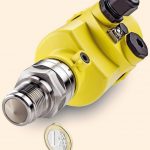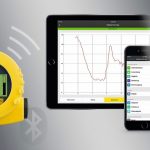Vega Grieshaber is now introducing Vegapuls 64, a radar level sensor for liquids that measures at a frequency of 80 GHz. This feature allows considerably better focusing of the radar beam. With this new instrument, measuring is much easier and more reliable, even under difficult conditions, for example in tanks fitted with heating coils, baffles or agitators.
No problems with heating coils, baffles or agitators
Radar level sensor for liquids with 80 GHz
Vega Grieshaber is now introducing Vegapuls 64, a radar level sensor for liquids that measures at a frequency of 80 GHz. This feature allows considerably better focusing of the radar beam. With this new instrument, measuring is much easier and more reliable, even under difficult conditions, for example in tanks fitted with heating coils, baffles or agitators.
Eighteen months ago, Vegapuls 69 – a new sensor for continuous measurements of bulk solids – was introduced with great success. This sensor also operates at a transmission frequency three times higher than the widely used 26 GHz. “The market has shown that this technology is the thing of the future – more than 10,000 Vegapuls 69 level sensors have already been installed since the launch”, says Jürgen Skowaisa, Product Manager Radar Instrumentation at Vega Grieshaber, describing the success story of these increased frequency sensors. The instruments have proven their worth, especially on media with poor reflective properties, in production shafts up to 120 m deep or in silos with numerous internal installations that generate strong false echoes.
Vegapuls 64 for liquid applications will follow this leap, also setting a milestone in measurement technology with its high dynamics and superior focusing. “Media with poor reflective properties, i. e. a low dielectric constant, can now be measured significantly better than with previous radar sensors”, Skowaisa continues. Thanks to the vastly improved focusing, the beam simply passes by internal tank installations or build-up. Interfering signals, which previously had to be filtered out with false signal suppression, now play virtually no role in the measurement process.
“What’s more, it’s now possible to use a much smaller antenna. Today, we have process fittings with an antenna diameter of only ¾“ – equivalent to the size of a one-euro coin.” The new technology also allows precise level measurements very close to the tank bottom. This opens up new perspectives for determining the level in the small containers that are the norm in the pharmaceutical and biotech industries or for gauging the amount of fuel left at the bottom of large fuel tanks. The measurement accuracy is +/-2 mm, even with a working range of up to 30 m.
The great success of the Vegapuls 69 bulk solids radar sensor and the current market launch of Vegapuls 64 for liquids are paving the way for the future technological development of radar level measurement. “There is currently no way to surpass the performance of radar measurement based on an operating frequency of 80 GHz”, adds Skowaisa with conviction.
High frequency for small vessels
The current trend in the chemical industry is towards smaller, specialised batches. This results in equipment and containers with a reduced volume. However, engineers everywhere – even in technical service centres and pilot plants – ran up against limits again and again when they tried to use radar level measurement technology in very small production setups. Factors like the sensor dead band, in particular, or the size and design of the antennas as well as the measurement uncertainty at the tank bottom often led them to use weighing systems or pressure transmitters instead. Vegapuls 64 now has an antenna system integrated directly into the process fitting. Since no antenna protrudes into the vessel, it is possible to measure right up to the process fitting itself. This gives greater flexibility because practically all of the container volume can be utilised.
Thanks to the tightly focused measuring beam – with an antenna diameter of 80 mm, the transmission signal has an opening angle of just 3° – using the instrument in tanks with heating coils and agitators is now much easier. Another advantage of Vegapuls 64 is its larger dynamic range, which results in higher measurement certainty, especially when there is build-up, condensate, foam or a turbulent liquid surface in the vessel.
Extra safety in liquid gas storage
The need for safety in the petroleum processing industry, for example when liquid gas is stored in spherical tanks, is especially great. The requirements in oil refineries are increasingly strict and sensors generally have to be mounted through ball valves. This is to ensure that if necessary, the sensors can be exchanged safely and easily without interrupting operation. Until now, Vega has generally not recommended this kind of installation for radar level sensors because the additional mounting socket and the ball valve itself cause strong interference and false echoes at close range. If a sensor was used to detect overfilling, for instance, the relatively small echoes from the medium could not always be reliably detected due to this strong noise generated near the sensor.
With Vegapuls 64, the impact of the ball valve is much lower, as the sensor has vastly better signal focusing and the mounting socket and ball valve thus reflect far fewer signals. Thanks to the higher frequency, namely 80 GHz, there are now many more possibilities for mounting sensors on shut-off valves than ever before. Another advantage for users is that the new sensor can be installed on existing shut-off devices – restricting modification and retrofitting costs to a minimum. The first sensors in the field have shown that Vegapuls 64 qualifies as a truly universal sensor. Besides LPG tanks without a standpipe, it can also measure the level reliably in practically any kind of storage or process tank.
Bluetooth opens up new possibilities
Almost simultaneously with the introduction of the Vegapuls 64 radar level sensor, Vega is causing yet another bang: the level and pres-sure instrumentation specialist is bringing a Bluetooth solution to the market. A new generation of Plicscom, the universal indicating and adjustment module, will allow all the transmitters in the plics instrument platform to be operated remotely via an app – easily, conveniently and securely. Wireless Bluetooth communication is suitable for all industries and particularly for applications in difficult-to-access locations, harsh industrial environments or hazardous areas. The best feature: the new module is downward compatible, which means it can be used on the entire installed base of more than 1.5 million plics sensors, many of which have been in operation since 2002. They are used in plants all around the globe – for all measuring principles, with a proven adjustment system and with no software updates.
Simply download the Vega Tools app and insert Plicscom into the instrument – that’s all! The plics sensors can be configured immediately, conveniently and from a safe distance using a smartphone or tablet with encrypted communication security. Remote indicating and diagnostic functions are also available.
For those who still want to adjust their plics sensors on site, Vega has another clever option up its sleeve: a magnetic pen allows contactless operation through the viewing window of the closed lid. The instruments are thus always well protected and even bad weather conditions or soiling cannot affect them – a major advantage compared to optical communication methods. The magnetic pen and Bluetooth communication offer a further benefit: costly and complicated authorisations to work in hazardous areas (hot work permits) are now a thing of the past.
Hall 4, Booth 514
www.cpp-net.com search: cpp0116vega
Günter Eckhardt
Günter Eckhardt
Editor-in-Chief,cpp chemical plants & processes
Share:











